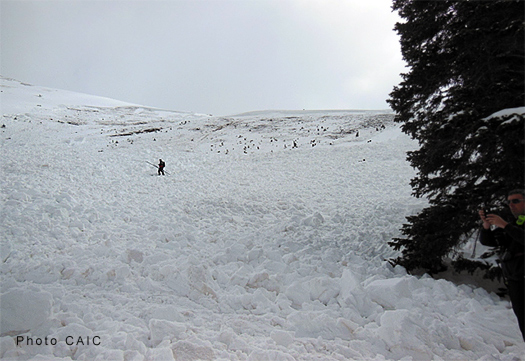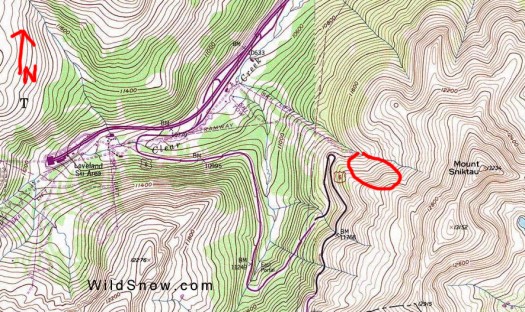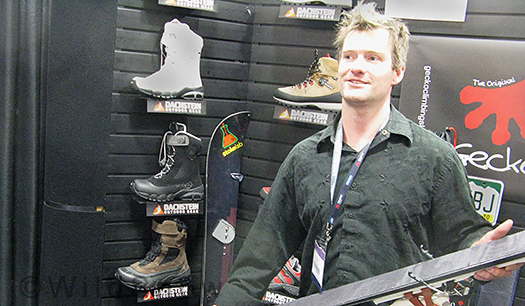This past Saturday, five men died in an avalanche near Loveland Pass, Colorado. This is the worst avalanche accident in our state since 1962 (Twin Lakes event), and is our worst ever involving backcountry skiers and riders (there have been worse in North America, such as 2003 Selkirks, 7 deceased). While no, I wasn’t there, I feel an obligation to put some thoughts down.

Sheep Creek avalanche debris field. Can you imagine coming on this scene, knowing at least five people are buried? I can barely wrap my head around it. Photo from Colorado Avalanche Information Center, used for educational purposes.
Above all, here at WildSnow we are deeply saddened by how tragic this is. Five vibrant human beings, snuffed in minutes while simply out having fun, leaving family and loved ones behind. When you think of the ever widening circles of grief this entails it is almost too much to comprehend. Deepest sympathy from us to all affected.
First in terms of analysis, it is sophomoric but probably necessary to say that this type of accident can happen to any of us. But hopefully not on this scale, and unlikely if we’re following what are accepted avalanche safety procedures.
It is known the group of six were split-boarding (backcountry uphill travel on a snowboard that converts to two skis) and ski touring in avalanche terrain near Loveland Pass known as Sheep Creek, under a northerly facing flank of Mount Sniktau (13,234 feet). By all appearances they were skirting the base of a suspect slope (which subsequently fell in the deadly slide). Some (or all) of the group were either in or above a terrain trap, topography that resulted in one person being buried about 15 feet deep, with other deep burials as well.

Approximate area of Sheep Creek avalanche. Looking at this map, it's difficult to ascertain why the group would have judged traveling here to be reasonably safe on this particular day. But then, micro route finding can result in good backcountry ski days even during high hazard, so I'm assuming that's what these individuals were engaged in and made a tragic error in judgment and procedure. Click to enlarge.
The exact goal for their day isn’t important. No matter what the Sheep Creek group was doing in the Loveland Pass zone, a fatal accident of this magnitude indicates an obvious breakdown in standard avalanche accident prevention techniques, notably, exposing fewer people at a time to a given hazard. Also, avalanche danger for the day was rated considerable and the slope the group was exposed to was the type the state avalanche center was cautioning about. In other words, due to the consequences it is fair and axiomatic to say the group was traveling too close together — while exposed to an obviously hazardous and known avalanche slope.
(In terms of avalanche safety, the terms “gang traveling” or “gang skiing” mean you are in a group and too close together to avoid exposing more than one person at a time to avalanche hazard. It has no particularly derogatory meaning, it is simply a descriptive term for a certain backcountry behavior.)
With that said, how about a look in the mirror?
None of us are perfect with how we deal with gang travel in avalanche terrain, as traveling one-at-a-time is one of the hardest protocols to maintain throughout a spirited day of backcountry skiing or snowboarding. Indeed, countless times I’ve been in a group who have, gang style, quickly scooted under a hanging wall of death or accidentally grouped together despite best intentions and inter-group discussion to the contrary.
More, the bigger your group the less practical the expose one-at-a-time rule becomes. Hence, ideal group size is one of the rules of thumb that avalanche educators throw around — and one we deal with nearly every time we get out backcountry skiing.
In my opinion, ideal group size is 3 or 4, with radios in use, and with clear goals of minimizing hazard. How often do Lisa and I achieve that ideal? Yep, our average is definitively not 100%, probably more around 75%. For example, just yesterday we had a good group size (3), but one of our radios malfed so I lost my motivation to really spread things out.
In other words, while groups of five or more backcountry skiers are a common sight, should they be an embarrassment like skiing without a beacon and and shovel? In the case of managing hazard exposure as well as other safety aspects (such as returning to the trailhead with one less person), then I’d say the answer is a loud YES. In the case of Sheep Creek, this was obviously so. Again, axiomatic.
Another worrisome thing about this tragedy is that it happened during an informally organized backcountry tour that was part of an event called “The Rocky Mountain High Backcountry Gathering”
Scrutiny of the organized event will no doubt happen. Meanwhile, my hope is this horrible tragedy will inspire self reflection on how we combine group dynamics with dangerous avalanche conditions.
Before some of you start shouting “you were not there, you can’t have an opinion,” let us step back and realize that no, we were not there, but lessons can be learned and we can all try to do better. We owe that to our friends and loved ones.

Winter Outdoor Retailer trade show 2012. Avalanche victim Ian Lamphere, worked in the ski industry as a gear importer.
We offer our sincere condolences to friends and loved ones of the victims. In particular, we knew Ian Lamphere from business dealings regarding Gecko climbing skins. Ian was a spirited booster of all things skiing — and a father. He’ll be missed.
Colorado Avalanche Information Center official report.
WildSnow.com publisher emeritus and founder Lou (Louis Dawson) has a 50+ years career in climbing, backcountry skiing and ski mountaineering. He was the first person in history to ski down all 54 Colorado 14,000-foot peaks, has authored numerous books about about backcountry skiing, and has skied from the summit of Denali in Alaska, North America’s highest mountain.
